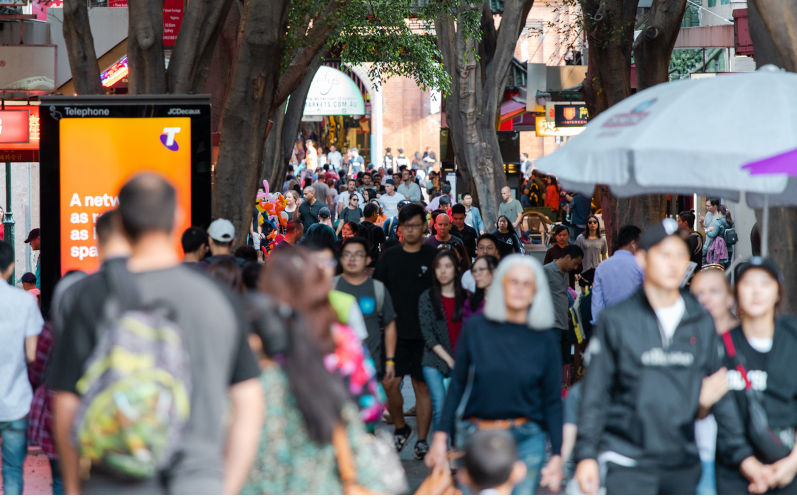Dialogue for Australia’s three voices
October 21, 2024
There is no doubt that the war in Gaza has placed Australia’s multiculturalism and social cohesion under strain.
Not since the Vietnam war has Australian society and politics witnessed such a surge of mass protests, intercommunal discord, and political polarisation. Framed in binary terms of “Israeli-Jewish versus Arab-Muslim”, Israel’s war in Gaza and beyond has fuelled sublinear grievances which threaten to spill-over into other realms.
It came at the completion of another polarised public discourse over the constitutional recognition of Aboriginal and Torres Strait Islander people. It was inevitable that the Government’s proposed Voice referendum would ignite a debate over Australia’s cultural identity. It has implicated, almost by default, Australia’s polymorphic non-indigenous non-British multicultural migrant cohort.
But very few places in the world offer themselves so readily to intercultural interaction and dialogue as Australia. When Australia’s first immigration minister, Arthur Calwell, mounted our nation’s post-war immigration programme, in addition to its economic and security imperatives, it also reflected a willingness ‘to move away from the conventional idea of Australia to a concept of a cosmopolitan society reflecting more pluralist cultural attitudes’.
If we are to make sense of modern Australia, including the ‘incompatibility’ between a plural coexistence of multi-cultural identities and the expectation for a single Australia of community values, much is to be gained by adopting a dialogical framework. The dichotomy of diversity and integration appears to be a recurring theme in Australia’s social structures and public debate.
Placing social change within the broader cultural context—as Noel Pearson noted in 2018—three strands inform Australia’s modern cultural identity: (1) its indigenous heritage; (2) the descendants of its Anglo-Celtic settlement—for Australians of non-British European descent, insisting on portraying it as ‘European settlement’ is as misleading as it is mischievous—and the subsequent mainstream ‘British institutions’; and, (3) the contribution of its ethnic migrant communities—or as Pearson generously describes the ‘gift of multicultural migration’.
Although numbers are not salient indicators of their political gravitas, it is important to note the comparative discrepancy in terms of access, equity, and interest of the three groupings. Based on the 2021 Census, a cursory look at Australian’s population reveals that First Nation Australians constitute approximately 3 per cent of the population, Anglo-Celtic Australians 54%, and Culturally and Linguistically Diverse (CALD) Australians, the remainder, 43%. A note of caution that these groupings are highly contentious, fractured and disputed. As a matter of fact, one of the challenges in search of Australia’s modern (and evolving) cultural identity, is to tease out these contentions and in doing so provide clarification in terms of context, boundaries, and relevance.
It is a sociological misnomer that the dominant ethno-cultural group in Australia dislikes being referred to as ‘Anglo-Australian’. This is not unique to Australia but constitutes the ‘prerogative’ of most majorities which are, at best, unmindful to difference and minorities.
Tensions over respect, recognition, belonging, integration, citizenship, loyalty, ownership and forging an Australian national identity have been prevalent ever since the arrival of the First (British) Fleet in 1788. While this contestation was largely played out between the British colonial settlers and the local indigenous population, with mass post-(WWII) war immigration, a third strand was introduced involving the newly arrived migrants as they brought with them their diverse languages, histories, memories, narratives, and religious and cultural practices. Here, of course, we need to mention the challenge that Catholic Irishness presented to Protestant Anglicanism during Australia’s colonial settlement period. Until the end of the Cold War, most of these tensions were consigned to the undercurrents of mainstream Australiana.
With the end of the Cold War, Australia’s democracy and multiculturalism have been severely tested. Sharp tensions have arisen in relation to international conflicts especially, but not exclusively, involving the Muslim world. These tensions, in turn, have fed into domestic concerns about Australia Muslims, rendering _The Scanlon Foundation Surveys 2018: Mapping Social Cohesion_, to ponder whether there is a return ‘Back to White Australia?’ Buttressed by globalisation, international conflict and environmental/planetary challenges, and the proliferation of the internet, polarisation over ‘identity politics’ have become immersed in the personal and the everyday. This is an unfortunate situation with collective unanimity and opposition to the ‘other’ side arising when a threat is felt.
However, recently, culture, as both public and government policy, while prominent in the public discourse, runs the risk of becoming severely polarising. At the very heart of this predicament is an apprehension of how to embrace a broader appreciation of Australia’s modern cultural identity. An identity that is set in a turbulent, tumultuous and ever changing world.
It might sound odd then, even counterintuitive, to suggest that under such tense circumstances we should suggest engaging in a frank and genuine dialogue. But to face the challenges mentioned above, and to lend real credence to social cohesion, we need to develop new instruments and new approaches.
Given the impact of the Covid-19, the referendum and the conflicts in the Middle East on our diverse communities, the need for instruments that advance intercommunal dialogue, understanding, engagement and thoughtful exchange are more needed than ever.
And instead of governments wasting finite resources and political capital on short-term band aids, they [would] do well to invest in dialogue so we can start understanding each other and in the process ourselves.
For if ever there was a need for dialogue in Australia, it is now.
